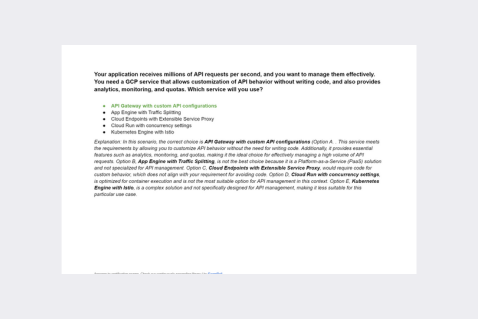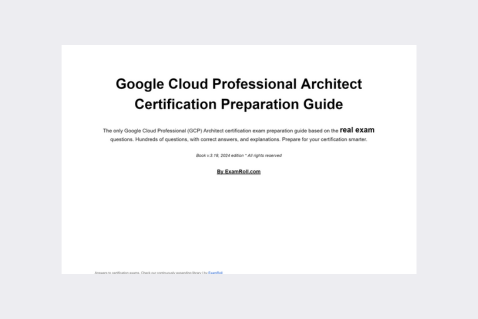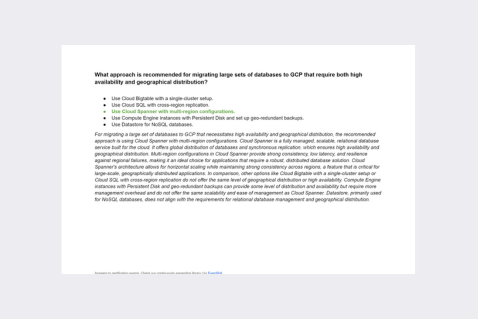The All-in-one Google Professional Cloud Architect Certification Exam Preparation Guide With Real Test Questions, Answers, and Explanations. The only Google Cloud Professional (GCP) Architect certification exam preparation guide based on the real exam questions. Hundreds of questions, with correct answers, and explanations.
Prepare for your certification smarter.
Lifetime free updates. Over 480 real exam questions.



- Over 480 Google Cloud Professional Architect certification exam questions with answers, and explanations.
- Real certification exam questions
- Detailed answer explanations.
- Free updates.
Are you aspiring to become a Google Cloud Professional Architect? The journey to achieving this prestigious certification can be rigorous, but with the right resources, it’s entirely within your reach. That’s where our “All-in-One Google Professional Cloud Architect Certification Exam Preparation Guide” comes into play, providing you with an indispensable tool to conquer the exam.
What Makes Our Guide Stand Out?
Our guide is meticulously crafted with a focus on helping you prepare effectively for the Google Cloud Professional Architect Certification Exam. It’s not just any study material; it’s a compilation based on the real exam questions. This means you’re getting a taste of what to expect, reducing surprises on the exam day.
Key Features of the Guide:
Real Exam Questions: We offer over 480 real exam questions. This extensive collection ensures that you cover a wide array of topics and question formats that are likely to appear in the actual exam.
Correct Answers and Explanations: Each question is accompanied by the correct answer and detailed explanations. This approach not only helps you in memorizing the answers but also in understanding the underlying concepts, which is crucial for a thorough comprehension of Google Cloud architecture.
Lifetime Free Updates: The cloud technology landscape is ever-evolving, and so is the certification exam content. Our guide comes with the promise of lifetime free updates, ensuring that you always have the most current and relevant material for your exam preparation.
Prepare Smarter, Not Harder: With a focus on real exam questions, our guide lets you prepare smarter. You spend your time efficiently by concentrating on the type of questions that matter most.
Why Trust Our Guide?
Our guide is not just a collection of questions; it’s a comprehensive tool designed to empower you with confidence and knowledge. Whether you’re a seasoned professional or new to Google Cloud, this guide caters to all levels of expertise. Its structured approach to presenting real exam questions, followed by answers and explanations, makes it a unique and powerful resource for your preparation journey.
Final Thoughts:
Embarking on the path to becoming a Google Cloud Professional Architect is a significant step in your career. With our “All-in-One Google Professional Cloud Architect Certification Exam Preparation Guide,” you’re not just preparing for an exam; you’re building a solid foundation for your future in the cloud technology realm. Invest in your success and make your certification journey smoother and more efficient. Prepare smarter and step confidently into your exam with our expertly crafted guide by your side.
Google Cloud Professional Architect Certification Exam Practice Test
Below you’ll find some mock questions with explanations. Check if you knew the answer. This covers some key aspects from the latest GCP Cloud Professional Architect certification.
When managing a globally distributed application that delivers both static and dynamic HTTP/HTTPS content, which Google Cloud Load Balancer configuration is most effective for ensuring high availability and low latency, particularly when a single IP address is needed for global routing?
- Global HTTP(S) Load Balancer
- Regional TCP Proxy Load Balancer
- Global SSL Proxy Load Balancer
- Regional External HTTP(S) Load Balancer
- Regional Internal HTTP(S) Load Balancer
Explanation: The Global HTTP(S) Load Balancer is the optimal choice for this scenario. It provides a single anycast IP, enabling global routing of traffic to the nearest data center, which is crucial for low latency and high availability. This type of load balancer is specially designed to handle both static and dynamic HTTP/HTTPS content efficiently, distributing traffic across multiple regions worldwide. The Global HTTP(S) Load Balancer’s intelligent routing ensures optimal performance by responding to users from the nearest location. The other options, such as Regional Load Balancers or SSL Proxy Load Balancers, either do not support the required HTTP/HTTPS protocols or are not configured for global distribution, thus failing to meet the requirements for a globally distributed application.
For a large-scale financial institution deploying machine learning models on GCP for fraud detection, with a stringent policy on data encryption at rest, in transit, and during ML computation, which GCP service or combination of services best aligns with these requirements?
- AI Platform Training with Customer-Managed Encryption Keys (CMEK)
- Data prep for feature engineering and AI Platform Prediction with default encryption
- AI Platform Training with CMEK and Secure ML
- BigQuery ML with CMEK and Data Loss Prevention API
- TensorFlow on GKE with Istio for in-transit encryption
Explanation: The most suitable choice is AI Platform Training with Customer-Managed Encryption Keys (CMEK) and Secure ML. This combination ensures that the data is encrypted at rest using CMEK, while Secure ML provides additional security during the machine learning computation process. This is vital for a financial institution dealing with sensitive information and needing to adhere to stringent security and compliance standards. AI Platform Training with CMEK allows for the customization of encryption keys, giving the institution control over its data encryption practices. In contrast, other options, such as using default encryption, BigQuery ML, or TensorFlow on GKE, might not fully meet the comprehensive encryption requirements (at rest, in transit, and during computation) as specified by the institution for its fraud detection models.
To establish a comprehensive data lake solution in GCP that handles batch and stream data ingestion, as well as transformations and analytics with SQL-like queries, which set of GCP services should be utilized?
- BigQuery, Cloud Pub/Sub, and Dataflow
- BigTable and Dataprep
- BigQuery and Dataprep
- Cloud Spanner, Dataflow, and BigQuery
- Cloud Storage, BigQuery, and Cloud Scheduler
Explanation: The combination of BigQuery, Cloud Pub/Sub, and Dataflow is the most suitable for building a robust data lake solution in GCP. BigQuery is a powerful data warehouse that supports SQL-like queries, making it ideal for analytics. Cloud Pub/Sub facilitates real-time data ingestion, which is crucial for handling stream data. Dataflow, on the other hand, provides a platform for both batch and stream data processing and transformations. This trio of services works together seamlessly to offer a comprehensive solution that covers all aspects of a data lake, including data ingestion, processing, and analysis. The other combinations, while having their own strengths, fall short in providing a complete solution that encompasses all these capabilities.
Following the migration of a monolithic application to a microservices architecture on GCP, which combination of services should be employed to ensure high availability, fault tolerance, and the facilitation of canary deployments?
- Compute Engine with Managed Instance Groups and Cloud Monitoring
- API Gateway with Cloud Endpoints and Cloud Armor
- Kubernetes Engine with Istio and Traffic Director
- App Engine with Traffic Splitting and Cloud CDN
- Cloud Functions with Pub/Sub and VPC Peering
Explanation: Kubernetes Engine combined with Istio and Traffic Director is the most effective solution for ensuring high availability, fault tolerance, and enabling canary deployments in a microservices architecture. Kubernetes Engine provides a managed environment for deploying containerized applications, which is crucial for a microservices setup. Istio enhances this by offering advanced traffic management capabilities, including canary deployments, allowing for gradual rollouts and efficient routing. Traffic Director further augments this setup by offering global load balancing, which is key for high availability and fault tolerance. The other service combinations, while useful in specific contexts, do not collectively offer the same level of support for high availability, fault tolerance, and canary deployments as does the Kubernetes-Istio-Traffic Director trio.
For a multinational corporation seeking a scalable and cost-effective solution on GCP to store and analyze large volumes of data, which service is most appropriate?
- Google Cloud Bigtable
- Google Cloud Storage
- Google Cloud Spanner
- Google Cloud Pub/Sub
- Google Cloud Dataflow
Explanation: Google Cloud Bigtable stands out as the most suitable service for a multinational corporation looking to store and analyze large volumes of data. It is a NoSQL database service that excels in handling massive analytical and operational workloads. Bigtable offers impressive scalability, enabling it to accommodate large-scale data requirements easily. This scalability is crucial for multinational corporations that deal with extensive datasets. Furthermore, Bigtable’s cost-effectiveness makes it an attractive option for organizations looking to optimize their spending while managing large data volumes. While the other services listed have their specific uses, none of them provide the same combination of scalability, performance, and cost-effectiveness for large-scale data storage and analysis as does Google Cloud Bigtable.
In designing a highly available GCP architecture for a worldwide e-commerce platform, which service is optimal for balancing traffic effectively while ensuring low latency for both IPv4 and IPv6 clients?
- Google Cloud Load Balancer with global HTTP(S) load balancing
- Google Cloud Traffic Director for advanced traffic management
- Google Cloud CDN for content delivery optimization
- Google Cloud Armor for DDoS protection
- Google Cloud NAT Gateway for network address translation
Explanation: The ideal choice for balancing traffic efficiently while maintaining low latency for both IPv4 and IPv6 clients in a global e-commerce platform is the combination of Google Cloud Load Balancer with global HTTP(S) load balancing and Google Cloud Traffic Director. The global HTTP(S) load balancer is adept at handling high volumes of traffic and supports both IPv4 and IPv6, ensuring accessibility and low latency across diverse client types. It’s particularly effective for global traffic distribution, essential for a worldwide e-commerce platform. Additionally, the Google Cloud Traffic Director provides advanced traffic management, seamlessly integrating with the Load Balancer to optimize traffic flow and response times. This combination addresses the core needs of a global, high-traffic e-commerce site, unlike the other options which focus on specific aspects like content delivery (CDN), security (Armor), or network address translation (NAT Gateway) without directly addressing global load balancing and latency concerns.
When your development team needs to deploy a new instance in the europe-central2 region, requiring access to an application on a Compute Engine instance in the us-west1 region within the same project, what is the recommended approach following Google’s best practices?
- Create a VPC and a subnetwork in europe-central2 region, expose the application with an internal load balancer, and use the load balancer’s address for the new instance in the subnetwork.
- Create a subnetwork in the same VPC in europe-central2 region, use Cloud VPN to connect the subnetworks, and use the first instance’s private address for the new instance.
- Create a subnetwork in the same VPC in europe-central2 region, and use the first instance’s private address for the new instance in the subnetwork.
- Create a VPC and a subnetwork in europe-central2 region, peer the two VPCs, and use the first instance’s private address for the new instance in the subnetwork.
Explanation: The recommended approach, in line with Google’s best practices, is to create a subnetwork in the same VPC in the europe-central2 region and then use the first instance’s private address for the new instance in this subnetwork. This method ensures seamless and secure communication between the two instances within the same VPC without introducing unnecessary complexity. It leverages the inherent connectivity features of a single VPC, facilitating efficient and direct communication between instances across different regions. This approach is preferable over others that suggest the use of additional components like internal load balancers, VPC peering, or Cloud VPN, which are not required for internal communication within the same VPC and can add unnecessary layers of complexity and potential points of failure.
For deploying a new instance in the europe-central2 region that needs to access an application on a Compute Engine instance in the us-west1 region within the same project, what is the recommended practice according to Google’s guidelines?
- Create a subnetwork in the same VPC in the europe-central2 region, then deploy a new instance in this subnetwork using the first instance’s private address as the endpoint.
- Utilize Cloud VPN to establish an encrypted tunnel between VPCs for secure connectivity.
- Implement VPC peering for inter-VPC private communication.
- Set up Cloud Router and BGP sessions for dynamic routing between VPCs.
Explanation: The most efficient and best practice according to Google’s guidelines is to create a subnetwork in the same VPC within the europe-central2 region, and then launch a new instance in this subnetwork, using the first instance’s private address as the endpoint. This method ensures direct, secure communication within the same VPC without the need for additional configurations or services. It simplifies the network setup and maintains private connectivity between instances in different regions of the same project. Other options like using Cloud VPN, VPC peering, or Cloud Router with BGP sessions introduce unnecessary complexity and are not required for internal communication within the same VPC, making them less suitable for this scenario.
When your development team plans to set up a new instance in europe-central2 with access requirements to an application on a Compute Engine instance in us-west1 within the same project, what would be the advisable approach following Google’s best practices?
- Establish a subnetwork in the same VPC in the europe-central2 region and provision a new instance in this subnetwork, utilizing the original instance’s private address as the endpoint.
- Employ Cloud VPN to facilitate encrypted tunnel connections between the VPCs.
- Apply VPC peering for private inter-VPC communications.
- Configure Cloud Router and BGP sessions for effective dynamic routing across VPCs.
Explanation: The advisable approach, in line with Google’s best practices, is to establish a subnetwork in the same VPC located in the europe-central2 region and then set up a new instance within this subnetwork, making use of the private address of the original instance as the endpoint. This strategy provides a streamlined and secure method of communication between instances in different regions, under the same VPC, without the necessity for more complex solutions. The use of Cloud VPN, VPC peering, or Cloud Router with BGP sessions, while viable in certain scenarios, adds additional layers of complexity and is generally not required for internal communications within the same VPC.
As a Cloud Engineer aiming to manage CPU and memory resources efficiently in a Kubernetes cluster, what should you configure to receive notifications if CPU usage exceeds 80% for 5 minutes or memory usage goes over 90% for 1 minute?
- Set up a complex alerting rule in a custom monitoring agent.
- Establish a Cloud Pub/Sub topic with a Cloud Scheduler job for alerts.
- Implement a custom logging pipeline to monitor resource usage.
- Formulate an alerting policy with specific conditions for CPU and memory usage thresholds.
Explanation: The most straightforward and effective approach for managing resource usage notifications in a Kubernetes cluster is to formulate an alerting policy that specifies conditions based on CPU and memory usage thresholds. This strategy is widely recognized as a standard practice in Cloud Monitoring. It enables precise and prompt notifications when resource usage exceeds predefined limits, thereby facilitating proactive management of the cluster’s performance. The creation of an alerting policy is a direct, standardized method that avoids the complexities and inefficiencies associated with setting up custom monitoring agents, Cloud Pub/Sub topics with Cloud Scheduler jobs, or custom logging pipelines. These alternative methods are generally more complex and less efficient for the specific task of monitoring and alerting based on CPU and memory utilization thresholds.
To establish development, test, and production environments in Google Cloud for a project, while ensuring consistency and adhering to Google’s best practices, what is the recommended approach?
- Create a unified Terraform configuration for all environments.
- Utilize the Cloud Foundation Toolkit to design a versatile deployment template, deployable across all environments using Terraform.
- Develop a Cloud Shell script incorporating gcloud commands for environment deployment.
- Formulate separate Terraform configurations for each environment, deploying them as needed.
Explanation: The optimal approach is to utilize the Cloud Foundation Toolkit to create a versatile deployment template that can be used across development, test, and production environments, and then deploy it with Terraform. This toolkit offers reference templates for both Deployment Manager and Terraform that align with Google Cloud’s best practices. By using a single, adaptable template, you ensure consistency across all environments while maintaining efficiency in deployment processes. Alternative methods like creating a single Terraform configuration, using Cloud Shell scripts, or having separate configurations for each environment may lack the consistency, scalability, and adherence to best practices that the Cloud Foundation Toolkit offers.
Given that the finance department requires logs from a financial application to be retained for five years, rarely accessed but available within three days if needed, what is the most suitable storage recommendation?
- Archive the logs in BigQuery for on-demand analysis.
- Transfer the logs to Cloud Storage and utilize Coldline storage class.
- Retain the logs in Cloud Logging for straightforward retrieval.
- Relocate the logs to Cloud Pub/Sub for process-driven analysis.
Explanation: The most suitable option for storing logs that need to be kept for an extended period but accessed infrequently is to export them to Cloud Storage and use the Coldline storage class. Coldline Storage is designed for long-term storage of data that is rarely accessed, offering a cost-effective solution with high durability. This storage class is perfect for archival purposes, like storing financial logs for five years, as it ensures data availability within a reasonable time frame (three days) while keeping costs low. Other options, such as storing in BigQuery, Cloud Logging, or using Cloud Pub/Sub, are not as efficient or cost-effective for long-term, infrequently accessed data storage.
Your company’s finance department requires long-term storage of logs from a financial application, with a five-year retention period and accessibility within three days on demand. What storage method would you recommend?
- Archive the logs for immediate analysis in BigQuery.
- Migrate the logs to Cloud Storage, opting for the Coldline storage class.
- Keep the logs readily accessible in Cloud Logging.
- Channel the logs through Cloud Pub/Sub for event-responsive processing.
Explanation: The most appropriate storage method in this scenario is to export the logs to Cloud Storage and select the Coldline storage class. Coldline Storage offers a highly cost-effective solution for storing data that is infrequently accessed but needs to be retained for long periods, such as the five-year requirement for financial logs. This storage class provides a balance of low cost, high durability, and reasonable access time, making it ideal for archival needs where data is not regularly accessed but must be available within a specific timeframe. In contrast, other options like BigQuery, Cloud Logging, or Cloud Pub/Sub are not primarily designed for long-term archival storage and may incur higher costs or lack the required accessibility for such use cases.



